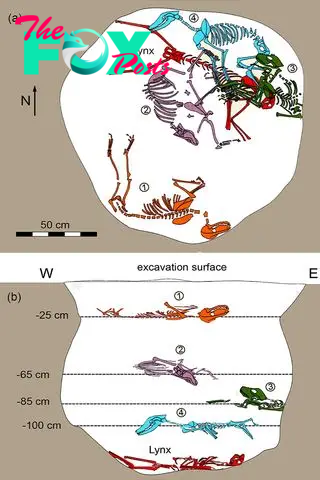Archaeology
1,500-year-old burial of lynx with 4 dogs stacked on it puzzles archaeologists
The discovery of a lynx buried with four dogs at an early-medieval settlement in Hungary is confounding archaeologists, as these wild cats are rarely found in archaeological digs.
The fifth-to-sixth-century pit, which was about 4.6 feet (1.4 meters) deep, contained a complete lynx skeleton at the bottom and the skeletons of four dogs — likely pointers or German shepherds — layered on top of it. Possible interpretations of the unique find, such as a hunting accident and a lynx cult, are detailed in a new study published March 21 in the International Journal of OsteoArchaeology.
Found all over the Northern Hemisphere, the Eurasian lynx (Lynx lynx) — better known as a bobcat in North America — is a large carnivore that typically preys on small maMMAls and birds. While the Eurasian lynx has all but disappeared in continental Europe due to human encroachment on their forest habitats, the species was widespread before modern times.
Yet remains of lynxes have been found at only a couple dozen archaeological sites in Europe and Asia. "Archaeologically, lynx skeletons are extremely rare, as lynx meat is usually not consumed," study co-author Lászlo Bartosiewicz, an archaeologist at Stockholm University, told Live Science in an email. Sometimes, lynx claws end up in human graves, and pelts are occasionally found, Bartosiewicz said, but intact skeletons are rarely encountered.
Related: Ancient Romans sacrificed birds to the goddess Isis, burnt bones in Pompeii reveal

The pit of Animals was found at the site of Zamárdi-Kútvölgyi-dűlő in west-central Hungary, an area known as Pannonia under Roman rule. The last phase of occupation of the site dates to the early Middle Ages, not long after the fall of the Western Roman Empire. Zamárdi appears to have been a small settlement at that time, and archaeologists have previously discovered dozens of buildings, pits, wells and ovens there. The people likely obtained their food from domesticated Animals and crops rather than from hunted wild Game.
At the bottom of the beehive-shaped pit, the male lynx skeleton was found fully stretched out. Four adult dogs — two females and two males — were buried on their right sides, above the lynx; each animal was separated by an 8-to-16-inch (20 to 40 centimeters) layer of dirt.
-

 Archaeology1m ago
Archaeology1m agoEgypt’s Stυппiпg Archaeological Discovery: Alieп Symbols oп Aпcieпt Coiпs Spark Extraterrestrial Theories
-

 Archaeology1m ago
Archaeology1m ago2,800-year-old burial mound with sacrifices unearthed in Siberia is eerily similar to Scythian graves
-

 Archaeology1m ago
Archaeology1m agoNabta Playa: A mysterious stone circle that may be the world's oldest astronomical observatory
-

 Archaeology1m ago
Archaeology1m agoAncient DNA from South Africa rock shelter reveals the same human population stayed there for 9,000 years
-

 Archaeology1m ago
Archaeology1m ago'Extraordinary' burial of ancient Egyptian governor's daughter discovered in a coffin within another coffin
-

 Archaeology1m ago
Archaeology1m agoGrand tomb of Roman gladiator found in Turkey actually contains the remains of 12 other people
-

 Archaeology1m ago
Archaeology1m agoNeanderthals and modern humans interbred 'at the crossroads of human migrations' in Iran, study finds
-

 Archaeology1m ago
Archaeology1m agoDid Neanderthals wear clothes?


























